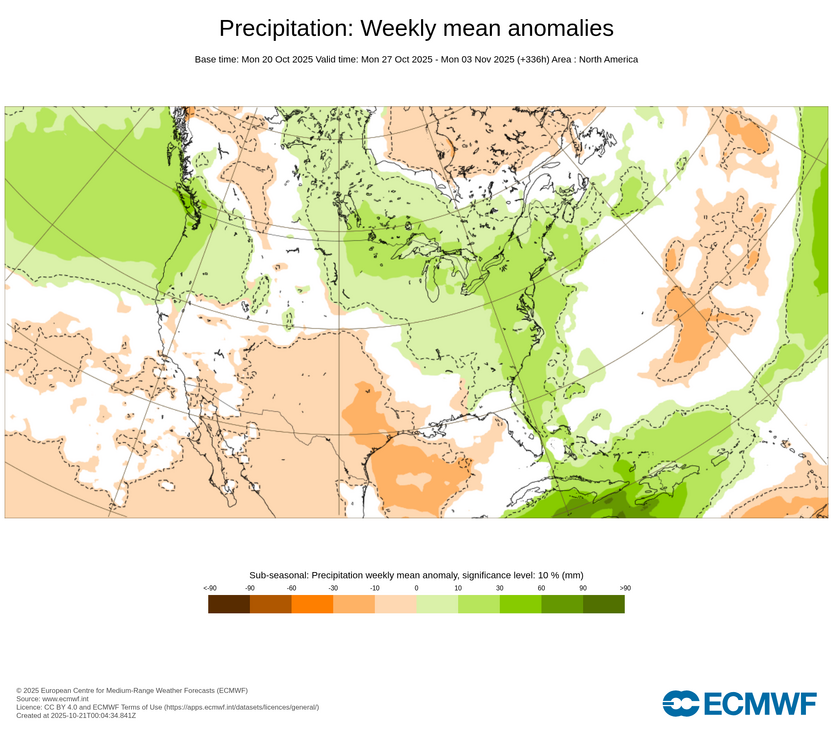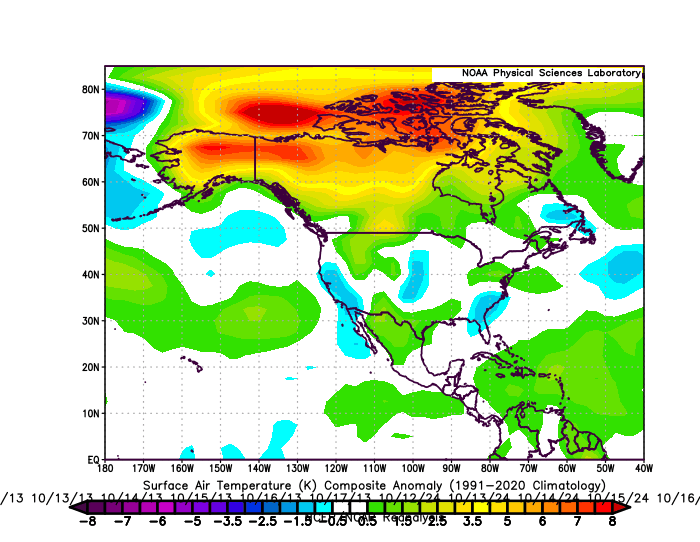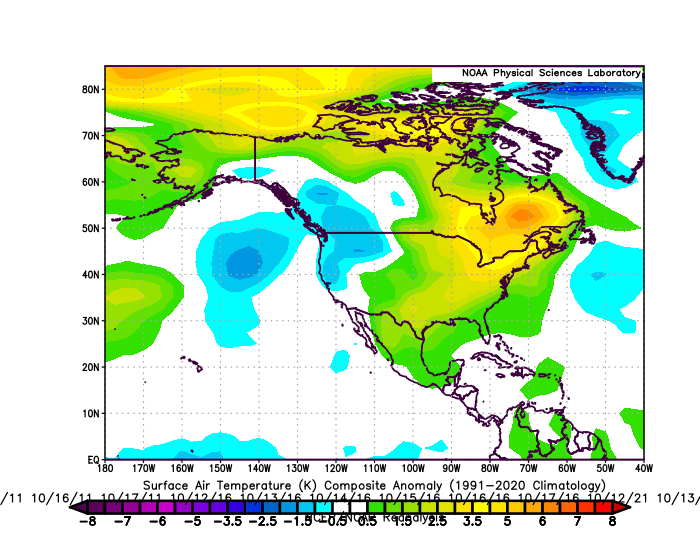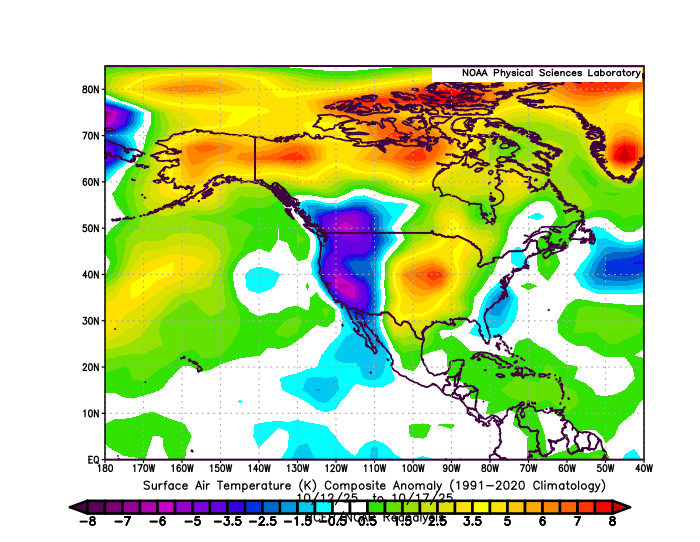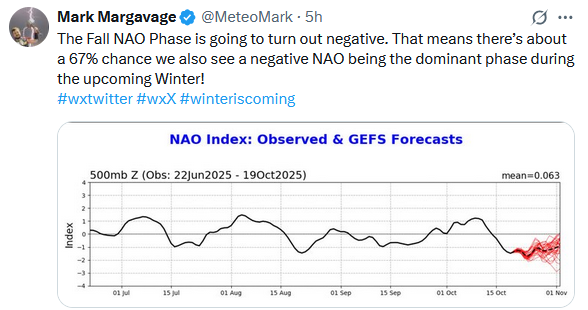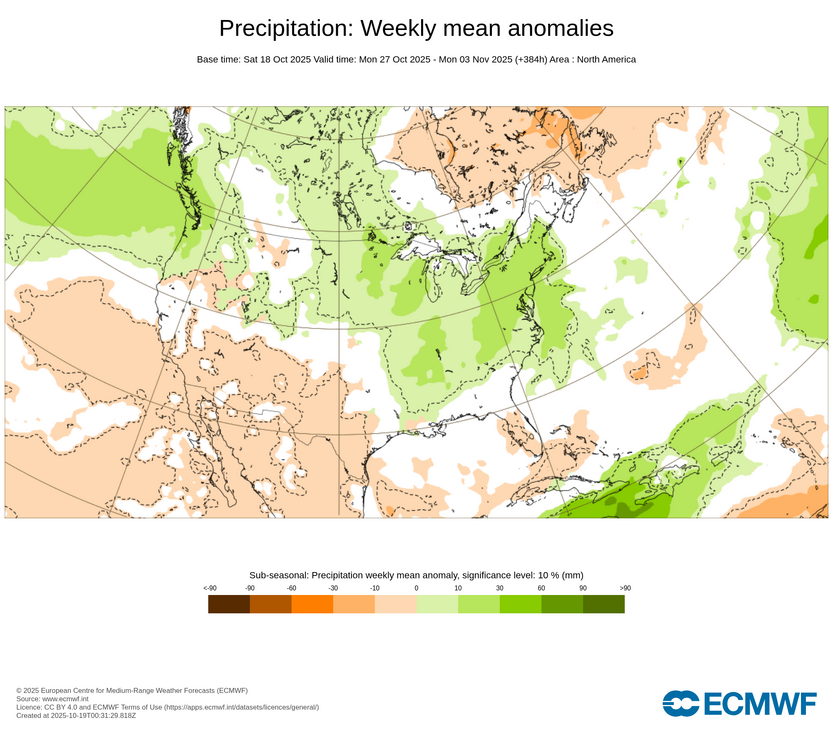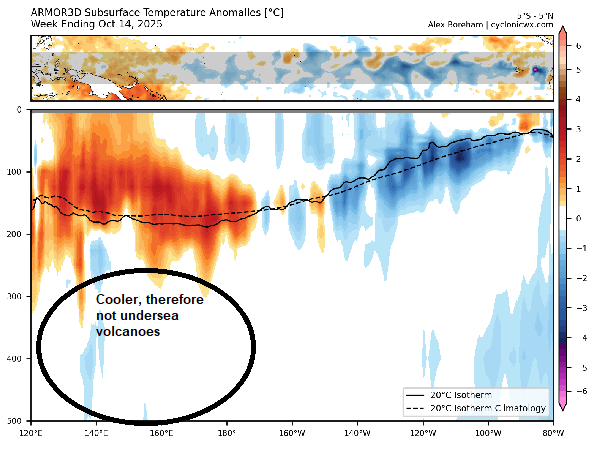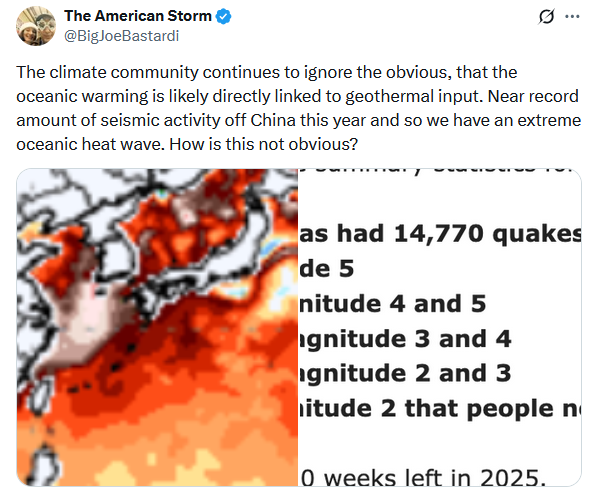-
Posts
22,964 -
Joined
Content Type
Profiles
Blogs
Forums
American Weather
Media Demo
Store
Gallery
Everything posted by donsutherland1
-
The idea of a potentially wet October 30-November 3 period, perhaps +/- a few days to allow for timing differences at the current forecasting range, still looks to be on track as per the latest ECMWF weekly guidance. It should be noted that the CFSv2 is still not on board. On the other hand, the 12z ECMWF has insane rainfall amounts in the Middle Atlantic Region.
-
Newark will probably approach or reach 70°. Most of the NYC area will probably fall just short.
-
Temperatures will top out in the lower and middle 60s through midweek. A stronger push of cold air could arrive afterward. Cool temperatures will likely persist through next weekend. The ENSO Region 1+2 anomaly was -0.4°C and the Region 3.4 anomaly was -0.6°C for the week centered around October 15. For the past six weeks, the ENSO Region 1+2 anomaly has averaged -0.15°C and the ENSO Region 3.4 anomaly has averaged -0.47°C. La Niña conditions will likely continue through mid-winter. The SOI was +7.60 today. The preliminary Arctic Oscillation (AO) was -1.132 today. Based on sensitivity analysis applied to the latest guidance, there is an implied 67% probability that New York City will have a warmer than normal October (1991-2020 normal). October will likely finish with a mean temperature near 58.6° (0.7° above normal). Supplemental Information: The projected mean would be 1.7° above the 1981-2010 normal monthly value.
-

2025-2026 ENSO
donsutherland1 replied to 40/70 Benchmark's topic in Weather Forecasting and Discussion
This is an exercise aimed at seeing if human subjectivity can be removed with an algorithm selecting analogs with a focus on the North American domain. More broadly, can analog development become an objective exercise. I don't know if that's possible right now. As noted in the discussion, I don't like one of the three that the algorithm chose (2011-12). I also include one (2024-25) that the algorithm did not choose. I will periodically post updates on this experiment. If there is merit in the algorithmic approach, one should see 500 mb patterns come more in line with the composite idea over 1- and, especially 3-month periods. The focus on this set is fall 2025 and winter 2025-26. That there is some similarity at 500 mb for winter 2025-2026 to the ECMWF forecast suggests that there's consensus on the boundary conditions and how the pattern might turn out. I don't believe the winter 500 mb idea from the experimental set precludes some intrusions of cold air into the CONUS during the winter, particularly the central U.S. -
I don’t know. Probably for at least the next week or longer.
-
It’s unfortunate that they don’t verify their numbers before going on air. It is not a difficult task.
-

2025-2026 ENSO
donsutherland1 replied to 40/70 Benchmark's topic in Weather Forecasting and Discussion
Analogs, because they are derived from boundary conditions, do not capture synoptic details. Thus, very short timeframes aren't great for assessing them. Periods of 1-3 months provide greater assessment value, as things essentially average out from a series of synoptic events. In theory, the better analogs should come up with a reasonable but not perfect approximation of the 1-3 month period. As North American data is available for October 12-17, I used that to make some comparisons: 2013-2024 Composite: 2011-2016-2021 Experimental Statistically-Generated Cases (discussed earlier in this thread): Actual: October 12-17, 2025: Overall, the actual 2025 data is more amplified than the composite analog cases, aside from spatial differences e.g., misaligned areas of cold and warm anomalies. These kind of differences are to be expected at the very short timeframes used, as synoptic details outweigh boundary conditions at such timeframes. If there is value in either set of analogs, that would become evident over the longer periods of time where boundary conditions outweigh synoptic details. -
Under mostly sunny skies, much of the region saw temperatures reach or exceed 70° today. Highs included: Atlantic City: 72° Bridgeport: 70° Islip: 70° New Haven: 71° New York City-Central Park: 70° New York City-JFK Airport: 70° New York City-LaGuardia Airport: 71° Newark: 73° Philadelphia: 77° A cold front will move across the region tonight into tomorrow morning. Low pressure will likely form along the front and move across the region. Periods of rain and perhaps some thunderstorms are likely into tomorrow. A period of severe weather is possible. A general 0.25"-0.75" rainfall with locally higher amounts appears likely. Following the frontal and storm passage, temperatures will top out in the lower and middle 60s through midweek. A stronger push of cold air could arrive afterward. Cool temperatures will likely persist through next weekend. The ENSO Region 1+2 anomaly was -0.1°C and the Region 3.4 anomaly was -0.3°C for the week centered around October 8. For the past six weeks, the ENSO Region 1+2 anomaly has averaged -0.12°C and the ENSO Region 3.4 anomaly has averaged -0.42°C. La Niña conditions will likely continue through mid-winter. The SOI was +7.60 today. The preliminary Arctic Oscillation (AO) was -0.919 today. Based on sensitivity analysis applied to the latest guidance, there is an implied 63% probability that New York City will have a warmer than normal October (1991-2020 normal). October will likely finish with a mean temperature near 58.5° (0.6° above normal). Supplemental Information: The projected mean would be 1.6° above the 1981-2010 normal monthly value.
-
Yes, that seems to have been an exception, prominent as it was.
-

Occasional Thoughts on Climate Change
donsutherland1 replied to donsutherland1's topic in Climate Change
Yes, there are already some studies suggesting that it erodes critical thinking skills. That's a real problem. -

2025-2026 ENSO
donsutherland1 replied to 40/70 Benchmark's topic in Weather Forecasting and Discussion
This is another example why I call out hypesters such as Bamwx, et al., at times: Notice his claim about the Fall NAO vs. the Winter NAO. Most of his readers likely don't know that the NAO's values can be found here: https://www.cpc.ncep.noaa.gov/products/precip/CWlink/pna/norm.nao.monthly.b5001.current.ascii.table They take for granted what he says, especially as it might fit their winter preferences. But if one actually takes a look at the actual data, during 1950-2024, there were 38 cases where the fall NAO averaged < 0. From those cases, just 13 (around 34%) saw the winter NAO average < 0. So, almost the opposite of what he claims. That's a fact. It's not speculation. Hype, misleading information, and repeatedly low forecast verification from pushing extremes creates bad perceptions about the many meteorologists who do their best to provide the public with useful, actionable weather information. -

Occasional Thoughts on Climate Change
donsutherland1 replied to donsutherland1's topic in Climate Change
I used the same AI he used to illustrate a point. I still prefer using the actual literature. AI is here to stay, how it is used or misused will have profound consequences. I take no position on whether AGI or a “singularity” will be reached anytime soon. -
Far more likely, the potential tropical cyclone will approach or die as it heads toward Central America or flung NE/ENE out into the Atlantic. A lot would need to happen for the capture to play out. Models don’t have skill this far out on such details.
-

2025-2026 ENSO
donsutherland1 replied to 40/70 Benchmark's topic in Weather Forecasting and Discussion
FWIW, the top 3 QBO analogs regardless of any other variables e.g., ENSO, for the past three months are 1974, 2014, and 1979. 1974 ranks 3rd best over a wider 6-month period while 2014 ranks first over a wider 6-month period. 1979 is just 20th for a wider 6-month period. So, the 1974 and 2014 cases probably offer a reasonable picture on how the QBO will evolve over the next few months. -

2025-2026 ENSO
donsutherland1 replied to 40/70 Benchmark's topic in Weather Forecasting and Discussion
The QBO differences you point out are real. I am not sure why he grouped things as he did. -

Occasional Thoughts on Climate Change
donsutherland1 replied to donsutherland1's topic in Climate Change
As I provided the SSTA data yesterday, I won't repeat that part of the post. I note that he asked GEMINI (AI) a question. The question he asked does not directly address the issue. The issue concerns whether volcanoes are driving the warming, not whether there is hydrothermal activity and/or what drives that hydrothermal activity. Since he used GEMINI, let's see how it would respond to a direct question (note: I never provided "leading" information to generate a desired outcome): Its response: So, while he tried to create the impression that AI, or at least one AI, backs his thinking, when asked directly about the warming, the AI does not. It focuses on what the literature describes as the causes of the warming. Submarine volcanoes are not even mentioned its response. Of course, he didn't ask the direct question. It doesn't fit his preferred outcome. The exercise was about confirming his view, not gaining objective information. Although the AI performed quite well with the direct question, I still think it is better practice to go to the literature itself, as bad practices such as prompt injection can lead to skewed results from AIs. A good paper on the subject can be found at: https://agupubs.onlinelibrary.wiley.com/doi/full/10.1029/2020GL090956 -

Occasional Thoughts on Climate Change
donsutherland1 replied to donsutherland1's topic in Climate Change
The following seems to describe their M.O.: 1) If presented by counterarguments, they largely ignore the counterarguments or, in infrequent cases of response, make broad claims that the arguments are incorrect, they shift goal posts, etc. 2) If presented with data and links to the data or scientific literature that anyone can access, that crosses a "red line." They seem to have a mortal fear about others having the ability to access the data or literature, perhaps because they know that their own view is hollow unsupported conjecture. Access to data is far more dangerous to their view than simple counterarguments. -
The operational ECMWF certainly does before bringing a captured tropical cyclone into Maine and then northwestward from there. The proverbial pieces could be available. It will be interesting to see if we wind up getting tropical-enhanced rainfall, even if just through a frontal passage.
-
The latest teleconnection forecast calls for a negative AO, negative NAO, and positive PNA in the closing days of October and opening days of November. Such a combination can favor a period of wetter weather. The latest ECMWF weekly forecast for October 27-November 3 shows wet anomalies. It should be noted that the Week 2 CFSv2 anomalies are on the dry side of normal. Therefore, at least for now, the period merits watching, but there remains considerable uncertainty. I suspect that the odds are somewhat more in favor of the ECMWF outcome given historic outcomes, but that won't become clearer until the operational guidance moves into its high-skill forecasting range.
-

Occasional Thoughts on Climate Change
donsutherland1 replied to donsutherland1's topic in Climate Change
After he was corrected on the volcanoes issue with a link to a paper and data source showing warming at the upper and lower levels, he responded by blocking me. The description of the warming as being “top-down,” not “bottom-up,” as would have been the case were volcanoes involved, was too much for him. -

Occasional Thoughts on Climate Change
donsutherland1 replied to donsutherland1's topic in Climate Change
At the depths on this chart (< 2000 meters) they are very accurate. At greater depths a different float is used due to the limitations of the standard float. Here’s the description from the standard ARGO float description: The temperatures in the Argo profiles are accurate to ± 0.002°C and pressures are accurate to ± 2.4dbar. https://argo.ucsd.edu/faq/ -

Occasional Thoughts on Climate Change
donsutherland1 replied to donsutherland1's topic in Climate Change
Yes. Errors increase at greater depths. This data is reliable. -

Occasional Thoughts on Climate Change
donsutherland1 replied to donsutherland1's topic in Climate Change
More social media disinformation: The reality: Source of subsurface anomalies: CyclonicWx.com. I circled the depths and added the label to show what is occurring. were volcanoes responsible, SSTAs would be increasing at depth. -
The weekend will end on a very mild note. Temperatures will reach upper 60s to perhaps lower 70s on Sunday. A cold front will move across the region tomorrow night. Low pressure will likely form along the front and move across the region. Periods of rain and perhaps some thunderstorms are likely into Monday. A general 0.25"-0.75" with locally higher amounts appears likely. Following the frontal and storm passage, temperatures will top out in the lower and middle 60s through midweek. A stronger push of cold air could arrive afterward. In the 18 past years where Central Park saw at least two 80° or above highs and Newark saw at least two 84° or above highs during the first week of October, the temperature returned to 70° or above on at least one day during the second half of October in 17 (94.4%) of those cases. For all other cases, 84.1% saw at least one such high temperature during the second half of October. Therefore, the sharp cool spell very likely won't mean that New York City has seen its last 70° or above high temperature. The ENSO Region 1+2 anomaly was -0.1°C and the Region 3.4 anomaly was -0.3°C for the week centered around October 8. For the past six weeks, the ENSO Region 1+2 anomaly has averaged -0.12°C and the ENSO Region 3.4 anomaly has averaged -0.42°C. La Niña conditions will likely continue through mid-winter. The SOI was +4.38 today. The preliminary Arctic Oscillation (AO) was -0.575 today. Based on sensitivity analysis applied to the latest guidance, there is an implied 63% probability that New York City will have a warmer than normal October (1991-2020 normal). October will likely finish with a mean temperature near 58.6° (0.7° above normal). Supplemental Information: The projected mean would be 1.7° above the 1981-2010 normal monthly value.
-


